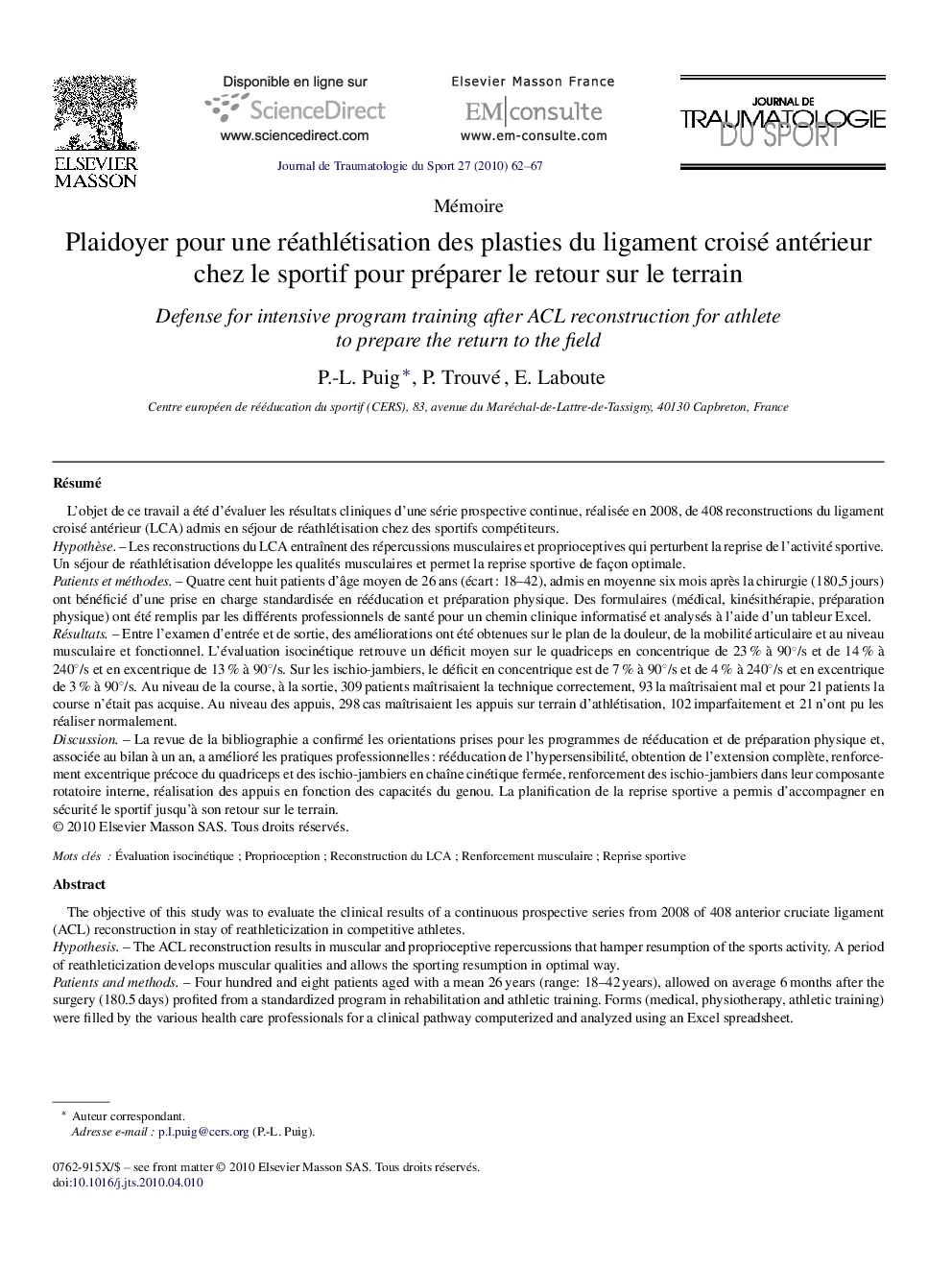| Article ID | Journal | Published Year | Pages | File Type |
|---|---|---|---|---|
| 4076841 | Journal de Traumatologie du Sport | 2010 | 6 Pages |
RésuméL’objet de ce travail a été d’évaluer les résultats cliniques d’une série prospective continue, réalisée en 2008, de 408 reconstructions du ligament croisé antérieur (LCA) admis en séjour de réathlétisation chez des sportifs compétiteurs.HypothèseLes reconstructions du LCA entraînent des répercussions musculaires et proprioceptives qui perturbent la reprise de l’activité sportive. Un séjour de réathlétisation développe les qualités musculaires et permet la reprise sportive de façon optimale.Patients et méthodesQuatre cent huit patients d’âge moyen de 26 ans (écart : 18–42), admis en moyenne six mois après la chirurgie (180,5 jours) ont bénéficié d’une prise en charge standardisée en rééducation et préparation physique. Des formulaires (médical, kinésithérapie, préparation physique) ont été remplis par les différents professionnels de santé pour un chemin clinique informatisé et analysés à l’aide d’un tableur Excel.RésultatsEntre l’examen d’entrée et de sortie, des améliorations ont été obtenues sur le plan de la douleur, de la mobilité articulaire et au niveau musculaire et fonctionnel. L’évaluation isocinétique retrouve un déficit moyen sur le quadriceps en concentrique de 23 % à 90°/s et de 14 % à 240°/s et en excentrique de 13 % à 90°/s. Sur les ischio-jambiers, le déficit en concentrique est de 7 % à 90°/s et de 4 % à 240°/s et en excentrique de 3 % à 90°/s. Au niveau de la course, à la sortie, 309 patients maîtrisaient la technique correctement, 93 la maîtrisaient mal et pour 21 patients la course n’était pas acquise. Au niveau des appuis, 298 cas maîtrisaient les appuis sur terrain d’athlétisation, 102 imparfaitement et 21 n’ont pu les réaliser normalement.DiscussionLa revue de la bibliographie a confirmé les orientations prises pour les programmes de rééducation et de préparation physique et, associée au bilan à un an, a amélioré les pratiques professionnelles : rééducation de l’hypersensibilité, obtention de l’extension complète, renforcement excentrique précoce du quadriceps et des ischio-jambiers en chaîne cinétique fermée, renforcement des ischio-jambiers dans leur composante rotatoire interne, réalisation des appuis en fonction des capacités du genou. La planification de la reprise sportive a permis d’accompagner en sécurité le sportif jusqu’à son retour sur le terrain.
The objective of this study was to evaluate the clinical results of a continuous prospective series from 2008 of 408 anterior cruciate ligament (ACL) reconstruction in stay of reathleticization in competitive athletes.HypothesisThe ACL reconstruction results in muscular and proprioceptive repercussions that hamper resumption of the sports activity. A period of reathleticization develops muscular qualities and allows the sporting resumption in optimal way.Patients and methodsFour hundred and eight patients aged with a mean 26 years (range: 18–42 years), allowed on average 6 months after the surgery (180.5 days) profited from a standardized program in rehabilitation and athletic training. Forms (medical, physiotherapy, athletic training) were filled by the various health care professionals for a clinical pathway computerized and analyzed using an Excel spreadsheet.ResultsBetween the income and outcome examination, improvements were obtained in the field of pain, range of motion , muscular and functional skills. The mean deficit of the isokinetic test for quadriceps of the operative limb was 23% at the speed of 90°/sec, 14% at the speed of 240°/sec and 13% at the speed of 90°/sec in eccentric. The mean deficit for hamstring was 7% at the speed of 90°/sec, 4% at the speed of 240°/sec and 3% at the speed of 90°/sec in eccentric. At the exit, 309 patients controlled running's techniques correctly, 93 controlled it little and for 21 patients, the running was not acquired. For running, 298 patients could control perfectly running on the field, 102 patients imperfectly and 21 could not realize them.DiscussionThe review of the bibliography confirmed the orientations taken for the programs of rehabilitation and of athletic training, and associated with the data collected, improved the professional practices: sensitive rehabilitation, normal range of motion with no loss of extension, early eccentric reinforcement of the quadriceps and hamstring in close kinetic chain, reinforcement of hamstring for internal rotation strength, running according to the capacities of the knee. The planning of the sporting recovery allowed going in full safety with the athletes to their return on the field or track.
